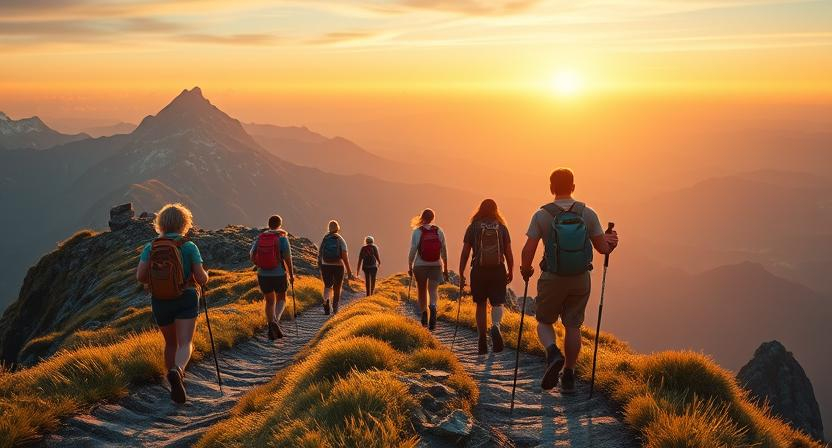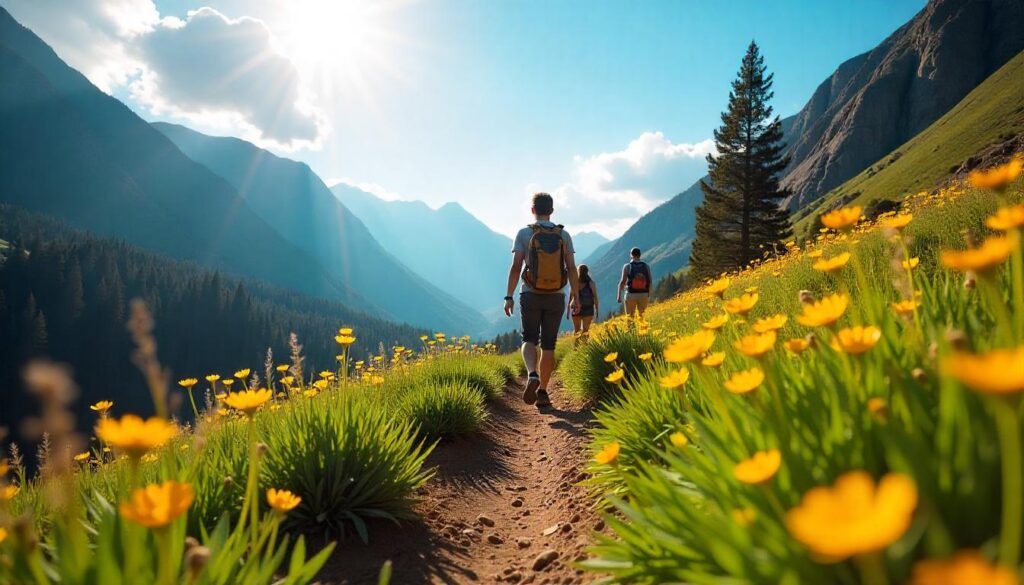
Welcome to Texas Hiking
Texas isn’t just about long rides on country roads and big cities—it’s a vibrant tapestry of diverse landscapes that beckon outdoor enthusiasts. Hiking in Texas offers a unique blend of experiences that range from rugged, rocky trails winding through the Texas Hill Country to peaceful walks along scenic state parks and even urban escapes in major cities like Austin and Dallas. Whether you’re drawn to the natural beauty of waterfall hiking trails in Texas or you simply want to experience the thrill of the best hiking trails in Texas, this guide is your all-inclusive resource for planning unforgettable adventures.
In Texas, you can explore an array of terrains that challenge your endurance while rewarding you with breathtaking vistas. The state’s vast and varied scenery means that every hike tells a story—from the majestic pink granite dome of Enchanted Rock to the serene, dew-kissed paths in lush state parks. Many trails offer not only a physical journey but also a deep connection with nature that is both spiritual and exhilarating. According to the Texas Parks and Wildlife Department (Texas Parks and Wildlife), the variety of ecosystems in Texas makes it one of the most appealing destinations for hikers looking for both adventure and tranquility.
What makes Texas hiking uniquely special is the year-round accessibility. With mild winters in the Hill Country, vibrant springs bursting with wildflowers, crisp autumn days painting the forests in rich hues, and cooling summer early mornings—the climate supports hiking in Texas every season. Whether you’re planning a quick day hike or a multi-day backpacking trip, this guide covers everything from hiking trails in Texas to tips on the best places to hike in Texas, ensuring that you find the right trail for your interests and fitness level.
Texas is also rich in local culture and community. Outdoor enthusiasts from across the state share tips, reviews, and stunning trail photos on social media, building a passionate Texas hiking community. If you’re new to the area, check out our Beginner’s Hiking Guide for expert advice on what to pack, how to stay safe, and tips on local hidden gems. Additionally, look into local Texas hiking tours offered by reputable companies for a guided experience that not only boosts your confidence but also deepens your connection with the outdoors.
Remember, every trail in Texas is a new adventure waiting to be discovered. So lace up your hiking boots, pack your essentials, and get ready to explore the diverse and awe-inspiring world of Texas hiking.
Why Hiking in Texas Is a Must
Diverse Landscapes and Scenic Trails
Texas offers a breathtaking mix of natural beauty that appeals to all types of hikers. Whether you are exploring the rugged terrain of the Texas Hill Country, wandering through expansive state parks, or discovering hidden trails in urban settings, every route unveils unique vistas. The state boasts some of the most diverse and beautiful hiking trails in Texas, making it easy to experience a new adventure each time you hit the trail. Outdoor enthusiasts appreciate how every path—from challenging mountain hikes to leisurely forest walks—showcases the essence of hiking in Texas.
Year-Round Outdoor Adventures
One of the standout features of hiking in Texas is the ability to enjoy it throughout the year. Seasonal variations offer something special: cool and refreshing air during the best winter hikes in Texas, vibrant wildflowers along the best spring hikes in Texas, and breathtaking autumn colors on the best fall hikes in Texas. With each season bringing its own natural spectacle, Texas ensures that every visit to the trails provides new scenery and experiences. The diverse weather patterns across regions, from the mild climates of hiking in Texas Hill Country to the brisk air in more elevated trails, means you can plan a hike that perfectly matches your mood and expectations.
Local Culture and Hiking Community
Texas is not just about the trails; it’s also a community. A rich culture of outdoor enthusiasts, local hiking tours, and resource guides like the Texas Hikers Field Guide connect people with insider tips and local trail secrets. Whether you’re a beginner or a seasoned hiker, joining the vibrant Texas hiking community helps enhance your experience on the trails. Local outfitters and organized Texas hiking tours offer expert guidance, ensuring that you get the most out of your hiking adventure while staying safe and informed.
Top 10 Best Hikes in Texas You Shouldn’t Miss
1. Enchanted Rock Trail – Central Texas

Introductory Paragraph
Enchanted Rock Trail is one of the most iconic hikes in Texas and an essential stop for anyone seeking the best hiking in Texas. Located in the heart of the Texas Hill Country, this trail is famed for its massive pink granite dome that rises prominently above the surrounding wilderness. The panoramic views from the summit offer a breathtaking perspective over rolling prairies and rugged terrain, making it a must-visit destination for outdoor enthusiasts.
Trail Distance, Difficulty & Permits
The trail is approximately 4.5 miles round-trip and involves a challenging ascent that demands a moderate level of fitness. The climb features a mix of rocky switchbacks and steep inclines, and while no special permits are required for day hiking, parking fees are enforced during peak periods. It’s important to check local guidelines before embarking on your adventure.
Best Time to Visit
The optimal seasons for hiking Enchanted Rock are spring and fall when the temperatures are milder, and the natural light is ideal for capturing panoramic views. Early morning hikes are highly recommended to avoid the afternoon heat and to enjoy serene conditions before crowds arrive.
Personal Tips & Safety Precautions
For a successful hike, wear sturdy hiking boots and bring a sufficient supply of water to stay hydrated. Be mindful of the rocky terrain, and consider using trekking poles for additional stability. Always check the weather forecast as sudden changes in temperature or wind can make the ascent more challenging.
2. Lost Mine Trail – Big Bend National Park
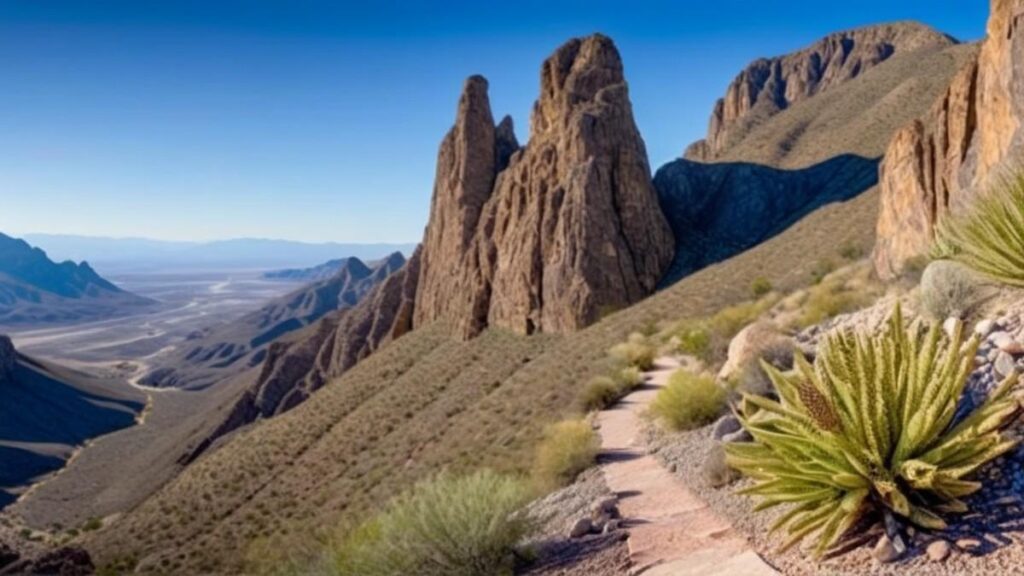
Introductory Paragraph
Lost Mine Trail offers a rugged, challenging adventure into the remote wilderness of Big Bend National Park. This trail is a favorite among experienced hikers seeking the thrill of exploring untamed terrain while enjoying dramatic desert vistas. Its secluded path and steep ascents create an engaging hike that exemplifies the spirit of Texas hiking.
Trail Distance, Difficulty & Permits
At roughly 4.8 miles one-way, Lost Mine Trail presents significant elevation gains and challenging switchbacks. Hikers should prepare for a physically demanding journey and check for any required permits or park fees prior to the hike. Detailed trail maps and recent park updates are available on the official Big Bend National Park website.
Best Time to Visit
For cooler temperatures and clearer vistas, early spring or late fall are the best times to experience Lost Mine Trail. These periods not only reduce the risk of heat exhaustion but also provide stunning views as the desert transforms with seasonal changes.
Personal Tips & Safety Precautions
Prepare adequately with plenty of water and sun protection. Using a reliable GPS and a detailed map is critical for navigation in the less-traveled areas of Big Bend. Ensure you have a solid base level of fitness due to the steep gradients and plan for regular breaks to maintain your energy levels.
3. Guadalupe Peak Trail – Texas’ Highest Point

Introductory Paragraph
Guadalupe Peak Trail is a strenuous yet immensely rewarding adventure that takes you to the highest elevation in Texas. Hikers are treated to spectacular panoramic views over desert landscapes and rugged mountains, making this trail one of the most sought-after experiences for those looking for the best hikes in Texas.
Trail Distance, Difficulty & Permits
This challenging hike spans approximately 8-9 miles round-trip and involves a significant elevation gain that tests even seasoned adventurers. Although permits are generally not required for day hikes, always verify any seasonal regulations or fees with local authorities before setting out.
Best Time to Visit
Visiting during cooler months such as late fall or early spring is ideal, as it prevents the extreme heat of the summer and allows for clear visibility of the expansive desert and mountain vistas. Early mornings are particularly beneficial to enjoy tranquil conditions and sunrise views.
Personal Tips & Safety Precautions
Wear appropriate hiking gear, including well-fitting, sturdy footwear and a hat to protect against harsh sunlight. Hydration is key on this trail, so carry extra water and electrolyte supplements. Check weather forecasts before the hike as conditions can change quickly at higher elevations, and consider using trekking poles for added stability.
4. Barton Creek Greenbelt – Urban Escape in Austin, Texas

Introductory Paragraph
Barton Creek Greenbelt is a beloved urban trail that blends natural beauty with city convenience. Located in Austin, this trail offers hikers a refreshing escape from urban life while providing stunning creek views and lush scenery. It is celebrated as one of the best hiking trails in Texas for those looking for an easy yet invigorating outdoor experience near a vibrant city.
Trail Distance, Difficulty & Permits
This popular trail provides various loop options ranging from 3 to 5 miles, making it accessible for both casual walkers and more adventurous hikers. The path features a mix of well-maintained paved segments and natural trails, and while there are typically no permits needed, parking fees may apply during busy periods.
Best Time to Visit
Early morning or cooler seasons are ideal for hiking the Greenbelt to enjoy its natural beauty without the interference of harsh urban heat. Avoid the midday rush to benefit from quieter, more serene conditions and softer lighting for photography.
Personal Tips & Safety Precautions
Plan your visit during weekdays to avoid overcrowding. Bring a lightweight jacket, as mornings in Austin can be cool, and always carry sufficient water. For navigation, use the official Austin Parks and Recreation trail maps, and consider joining a local hiking group to learn insider tips on the best segments of the trail.
5. McKinney Falls State Park Trails – Austin Area
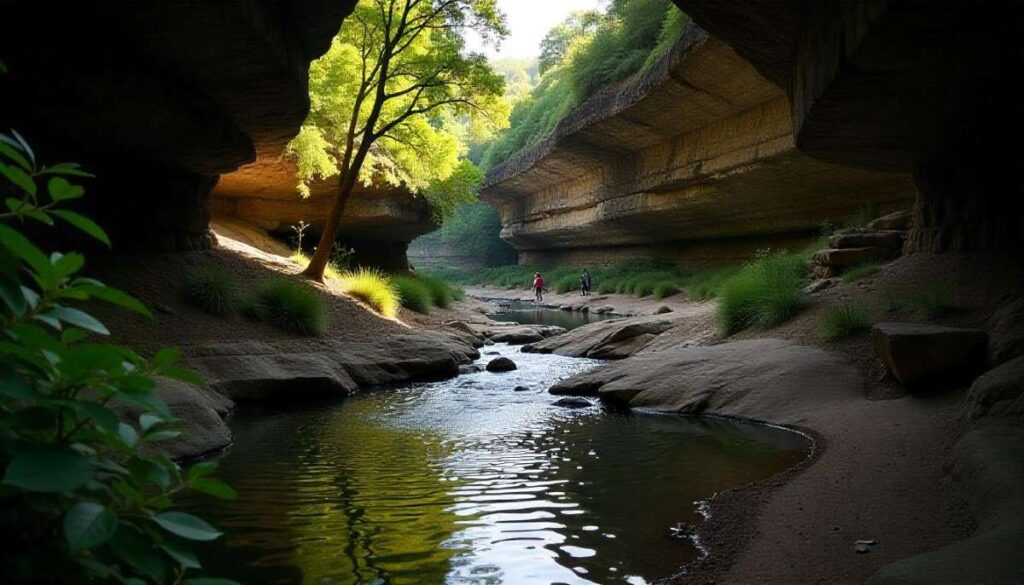
Introductory Paragraph
McKinney Falls State Park Trails offer a scenic escape in the heart of Central Texas, featuring enchanting waterfalls, rugged canyons, and lush, green landscapes. This state park is a favorite destination for both casual family outings and dedicated hikers seeking diverse trail experiences, solidifying its position as one of the best hikes in Texas.
Trail Distance, Difficulty & Permits
With trails ranging from easy, family-friendly loops to more challenging hikes that extend deeper into the park, visitors can choose a route that matches their fitness level. A modest park fee applies at the entrance, and some longer trails may require additional permits or early reservations during peak times.
Best Time to Visit
Spring and fall are the best times to visit McKinney Falls State Park, when the weather is pleasant and the waterfalls are at their most vibrant. Early mornings are ideal to capture the beauty of the falls in soft, natural light while avoiding the midday heat.
Personal Tips & Safety Precautions
Ensure you pack insect repellent and extra water, especially during warm days. Check the park’s website for current conditions and any potential trail closures. For a more relaxed experience, plan your trip on a weekday. Familiarize yourself with the trail layout using available park maps, and don’t forget to carry a basic first-aid kit.
6. Oak Cliff Nature Preserve – Dallas, Texas
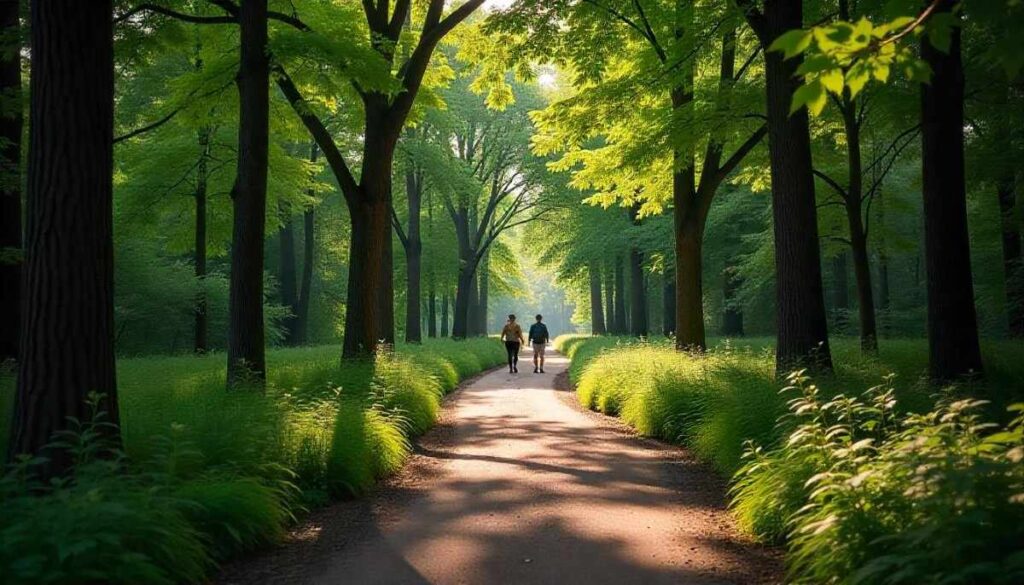
Introductory Paragraph
Oak Cliff Nature Preserve in Dallas is a hidden gem that offers an urban escape with quiet, lush trails and a peaceful natural environment. This trail is perfect for those looking to combine city living with outdoor exploration, making it a valuable addition to any guide on the best hiking in Texas.
Trail Distance, Difficulty & Permits
The preserve features several short trails, typically ranging between 2 and 4 miles, with mostly easy to moderate difficulty. No permits are required, though some areas may have a small fee for parking or maintenance during peak seasons.
Best Time to Visit
For the best hiking experience, visit during the early morning or in the late afternoon when the temperatures are cooler and the natural light is ideal. This also helps you avoid the busiest times when the urban crowd might be at its peak.
Personal Tips & Safety Precautions
Keep your smartphone handy for navigation via digital trail maps provided by the preserve’s website. Bring water, especially if you plan to extend your walk, and dress in layers to adapt to changing urban microclimates. Enjoy the urban-nature balance by taking breaks at designated rest spots along the trail.
7. Brazos Bend State Park Trails – Houston Area

Introductory Paragraph
Brazos Bend State Park Trails near Houston are known for their abundant wildlife, scenic landscapes, and diverse trail options. This park is an excellent destination for hikers who want a mix of dense woodlands, open fields, and the opportunity to see native Texas flora and fauna up close—all making it one of the best hiking destinations in Texas.
Trail Distance, Difficulty & Permits
Trails at Brazos Bend vary greatly in length and difficulty, from short, leisurely loops to more challenging, extended routes. Park entry generally requires a small fee, and some specific trails might have permit requirements during busy periods. Always check the park’s latest guidelines prior to your visit.
Best Time to Visit
Spring and fall are ideal for exploring Brazos Bend, when temperatures are moderate and wildlife activity is at its peak. Early mornings are optimal to avoid the heat and to get more intimate with the local fauna.
Personal Tips & Safety Precautions
Bring insect repellent and a reusable water bottle, as you may encounter mosquitoes and other bugs. It’s advisable to wear trail shoes with good grip due to the sometimes slippery trails. For real-time updates, consult the Texas Parks and Wildlife Department before heading out.
8. Hill Country Loop Trails – Texas Hill Country

Introductory Paragraph
The Hill Country Loop Trails in Texas offer an exceptional glimpse into the rugged beauty and cultural charm of the region. These trails, set against the backdrop of rolling hills and dramatic rock formations, represent the very best hiking in Texas hill country, where each loop provides a unique and ever-changing scenic experience.
Trail Distance, Difficulty & Permits
Typically ranging between 4 and 8 miles, these loop trails vary in difficulty from moderate to challenging, often featuring rocky paths and varying elevations. Some loops are within state parks and might require a small entrance fee or permit, so always review the latest park guidelines before your excursion.
Best Time to Visit
The fall is perfect for these trails, when the foliage turns vibrant and the temperatures are cooler. Spring also offers wildflower blooms that add spectacular color to the landscape. Early morning trips will help you avoid the crowded midday heat.
Personal Tips & Safety Precautions
Ensure you have a reliable map or trail app, as some loops can be hard to follow without clear markers. Pack extra water and sun protection, and consider a light backpack with essential gear. Familiarize yourself with local weather forecasts, and always check for any trail updates on the Texas Hill Country website.
9. Sam Houston National Forest Trails – East Texas
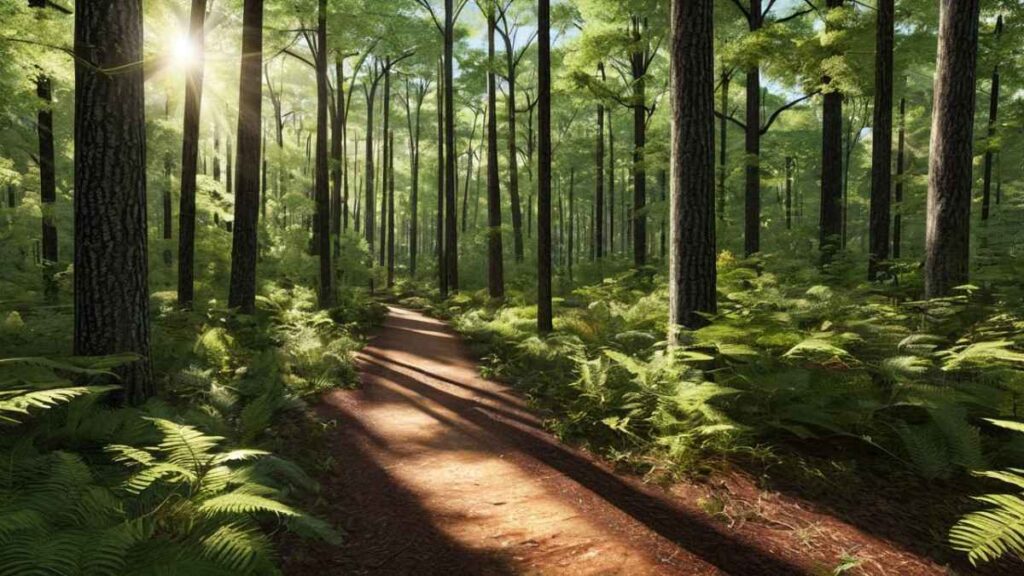
Introductory Paragraph
Sam Houston National Forest Trails in East Texas provide an immersive experience within dense woodlands and along cool, meandering streams. These trails are perfect for hikers seeking a tranquil retreat from urban life, offering lush, shaded paths and an opportunity to experience East Texas’s natural diversity.
Trail Distance, Difficulty & Permits
Trail lengths in Sam Houston National Forest vary from short loops to extended treks, typically falling into the moderate difficulty category. Some routes may require a nominal park fee or permit on weekends, so it’s best to check the forest’s official website for up-to-date information on access.
Best Time to Visit
For an optimal experience, early spring and fall are recommended, as these seasons deliver cooler temperatures and vibrant natural scenes in the forest. Morning hikes ensure ample daylight and fewer crowds, contributing to a more peaceful hike.
Personal Tips & Safety Precautions
Bring insect repellent and a detailed trail map to navigate the winding paths effectively. It’s wise to carry extra water and a snack, especially during longer treks. Always inform someone of your hiking route, and familiarize yourself with the trail layout using Sam Houston National Forest’s resources.
10. Longhorn Trail – West Texas Wilderness

Introductory Paragraph
Longhorn Trail epitomizes the wild, untamed spirit of West Texas. This iconic hike offers an adventure into remote, rugged terrain, where the isolation and expansive landscapes allow hikers to experience true solitude and awe-inspiring natural beauty. It stands as one of the best hiking trails in Texas for those seeking an uncompromised wilderness experience.
Trail Distance, Difficulty & Permits
Longhorn Trail is recognized for its challenging, lengthy route—often exceeding 10 miles one way—and steep elevation changes. Due to its remoteness, some sections require a permit or advanced registration, so checking with local authorities and the Texas State Parks website is essential before embarking on the hike.
Best Time to Visit
The cooler months, particularly late fall and early spring, are most suitable for tackling Longhorn Trail, when extreme temperatures are mitigated and the terrain is more manageable. Early morning hikes are recommended to take advantage of calmer conditions and softer light.
Personal Tips & Safety Precautions
Due to the trail’s isolation, hikers should always carry a fully charged GPS device, extra water, and emergency supplies. Prepare for rugged terrain with quality hiking boots and trekking poles. Inform a friend or local ranger of your planned route and schedule, and always check weather conditions before and during your hike.
Comparison Table: Top 10 Best Hikes in Texas
| Trail Name | Distance | Difficulty | Permit Required | Best Time to Visit |
|---|---|---|---|---|
| Enchanted Rock Trail (Central Texas) | 1.6 miles (Summit Trail) | ⭐️⭐️⭐️ Moderate | Yes (Day-Use Reservation) | Spring & Fall (cooler temps) |
| Lost Mine Trail (Big Bend NP) | 4.8 miles (out & back) | ⭐️⭐️⭐️ Moderate | No (Entry Fee to Park) | March–May, Oct–Nov |
| Guadalupe Peak Trail (Highest Point in TX) | 8.4 miles (out & back) | ⭐️⭐️⭐️⭐️ Hard | No (Entry Fee to Park) | Fall & Spring |
| Barton Creek Greenbelt (Austin) | Up to 12 miles (multiple access points) | ⭐️⭐️ Moderate | No | Spring (flowing creeks) |
| McKinney Falls SP Trails (Austin Area) | 2.8 miles (Onion Creek & Rock Shelter Loop) | ⭐️⭐️ Easy | Yes (State Park Fee) | Spring, Fall |
| Oak Cliff Nature Preserve (Dallas) | 8 miles (loop network) | ⭐️⭐️ Easy–Moderate | No | Fall, Winter, Spring |
| Brazos Bend SP Trails (Houston Area) | 37 miles (varied loops) | ⭐️⭐️ Easy | Yes (State Park Fee) | Winter & Spring |
| Hill Country Loop Trails (TX Hill Country) | Varies (3–15 miles) | ⭐️⭐️⭐️ Moderate | No | Late Fall & Spring |
| Sam Houston National Forest Trails (East TX) | 128 miles (Lone Star Trail – full) | ⭐️⭐️⭐️ Moderate | No | Late Fall to Early Spring |
| Longhorn Trail (West Texas) | ~6 miles (varied terrain) | ⭐️⭐️⭐️ Moderate | May vary (check locally) | Spring & Fall |
Regional Hiking in Texas: Explore by Area
Texas is home to diverse geographic regions that offer some of the most scenic and varied hiking experiences in the U.S. From the limestone cliffs and wildflower meadows of the Hill Country to the desert solitude of West Texas, each region brings its own flavor, challenges, and unique outdoor culture. Whether you’re a seasoned hiker or just looking for a weekend escape, understanding the hiking opportunities by region will help you better plan your next outdoor adventure in the Lone Star State.
Hiking in Texas Hill Country
Texas Hill Country is widely considered one of the most picturesque hiking regions in the state. Located in Central Texas, this area features rolling limestone hills, crystal-clear rivers, vibrant wildflowers, and ancient cypress trees. It’s especially popular for spring hikes when bluebonnets and Indian paintbrushes blanket the hillsides.
Trails like the Enchanted Rock Summit Trail offer panoramic views from a giant pink granite dome, providing not just scenic beauty but also geological intrigue. The Hill Country State Natural Area and Pedernales Falls State Park are also great choices for both day hikers and backpackers, with trails winding through rocky terrain and cedar breaks.
Hiking here is also culturally rich. You’ll often pass historical landmarks, German-influenced towns like Fredericksburg, and local wineries that give Hill Country its unique identity. Many trails offer interpretive signs that highlight the area’s diverse flora, fauna, and heritage, making hikes educational and immersive.
Expert Tip: Spring and fall are the best seasons to explore Hill Country trails due to mild temperatures and seasonal beauty. Bring sturdy hiking shoes with good grip—the limestone can get slick after rain. Also, start early to avoid afternoon heat, especially on exposed trails like those at Enchanted Rock.
Hiking in North Texas, Central Texas, and West Texas
North Texas:
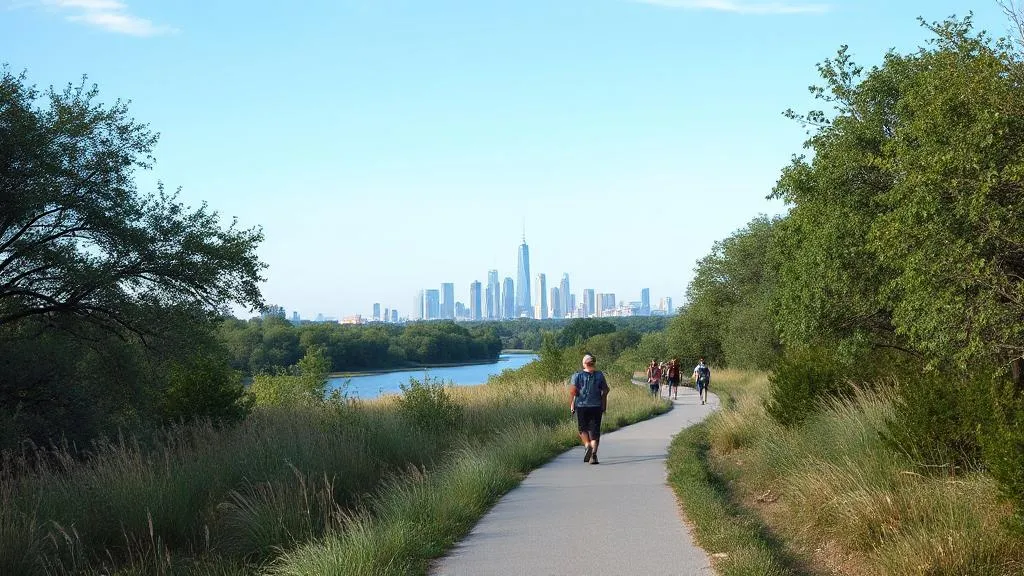
Hiking in North Texas—especially around Dallas and Fort Worth—blends urban accessibility with pockets of natural escape. Oak Cliff Nature Preserve in Dallas provides a great example: its 8 miles of wooded trails feel secluded while sitting just minutes from the city. Other great options include Cedar Ridge Preserve and Arbor Hills Nature Preserve, where rolling hills and diverse bird species offer a surprising escape from city life.
While elevation gains are modest, North Texas trails often pass through scenic prairie lands, creeks, and oak forests. These areas are especially enjoyable during late fall and early spring when the air is crisp, and the leaves put on a colorful show.
Central Texas:

Beyond Hill Country, Central Texas expands into regions around Waco and San Antonio. McKinney Falls State Park near Austin is a favorite, known for its short, accessible trails and unique limestone ledges carved by Onion Creek. Farther south, Government Canyon State Natural Area offers longer, more rugged options with a remote feel—ideal for intermediate hikers seeking solitude.
You’ll find an intriguing mix of dry canyonlands and wooded terrain, often with signs of Central Texas wildlife like armadillos and white-tailed deer. The terrain here is moderately challenging, with rocky paths and elevation changes that make for a fulfilling hike without being too technical.
West Texas:
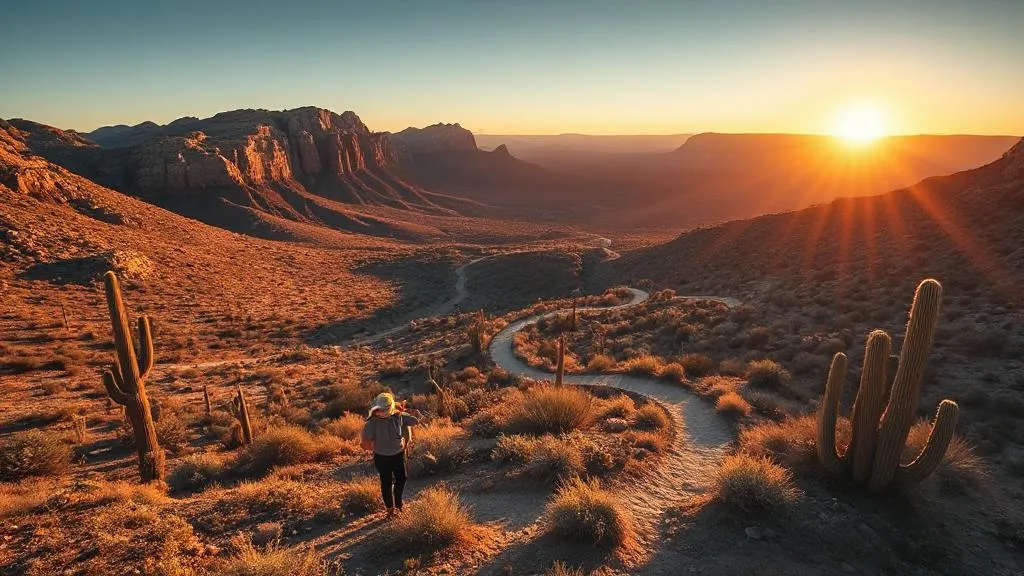
West Texas delivers some of the most awe-inspiring and challenging hikes in the state. Trails in Big Bend National Park and Guadalupe Mountains National Park are renowned for dramatic desert landscapes, high elevation gains, and absolute solitude. The Lost Mine Trail offers epic views across the Chisos Mountains, while the Guadalupe Peak Trail takes you to the highest point in Texas at over 8,700 feet.
These hikes are ideal for experienced hikers comfortable with high desert conditions, variable weather, and limited water access. They also present unmatched star-gazing and photography opportunities due to low light pollution and open horizons.
Expert Insight: In West Texas, always carry more water than you think you’ll need—at least 3 liters per person for long hikes. A topographic map or GPS is essential, as some trails have limited signage and cell reception is unreliable.
Hiking in Austin and Other Major Cities
Urban hiking in Texas is a hidden gem for those looking to stay close to city centers while still enjoying nature. Cities like Austin, Houston, and Dallas have invested in preserving green spaces that double as excellent hiking and biking corridors.
Austin
Austin is a hiker’s paradise thanks to its unique geography that includes limestone bluffs, spring-fed creeks, and urban wilderness areas. The Barton Creek Greenbelt is perhaps the most well-known, offering over 12 miles of interconnected trails that range from beginner-friendly to moderately difficult. Highlights include swimming holes like Twin Falls and Sculpture Falls, perfect for cooling off during the summer months.
Just outside the city, St. Edwards Park and Mayfield Preserve offer shorter but equally scenic trails that showcase the region’s biodiversity and provide peaceful escapes from the bustling city.
Pro Tip: Start early during summer months to avoid extreme heat and bring a map if you’re unfamiliar with Greenbelt trail junctions—they’re not always clearly marked.
Houston
Hiking in Houston is often underrated. The Houston Arboretum & Nature Center, Memorial Park, and Terry Hershey Trail offer miles of green corridors through forested and wetland areas. The trails are mostly flat and accessible, making them great for families or those new to hiking.
The Brazos Bend State Park, just outside Houston, provides more of a wilderness experience with swampy landscapes, alligator sightings, and birdwatching opportunities. It’s perfect for day hikers who want a mix of adventure and nature education.
Safety Tip: Always use insect repellent in Houston trails—mosquitoes and ticks are common, especially near water bodies. Stay on marked paths to avoid run-ins with wildlife.
Waterfall Hiking Trails in Texas
Despite its arid reputation in some regions, Texas offers an impressive selection of waterfall hiking trails that surprise and delight outdoor enthusiasts. From hidden cascades in shaded canyons to thundering falls after heavy rainfall, these natural features elevate hiking experiences across the state. For nature lovers and photographers alike, waterfall hiking trails in Texas provide not only scenic value but also a refreshing environment that enhances both physical and mental well-being.
Whether you’re seeking a short family-friendly trail or a rugged backcountry adventure, several hiking trails in Texas with waterfalls deliver on beauty, challenge, and uniqueness. Below is a detailed exploration of the most captivating waterfall hikes the Lone Star State has to offer.
Recommended Waterfall Trails
1. Gorman Falls – Colorado Bend State Park
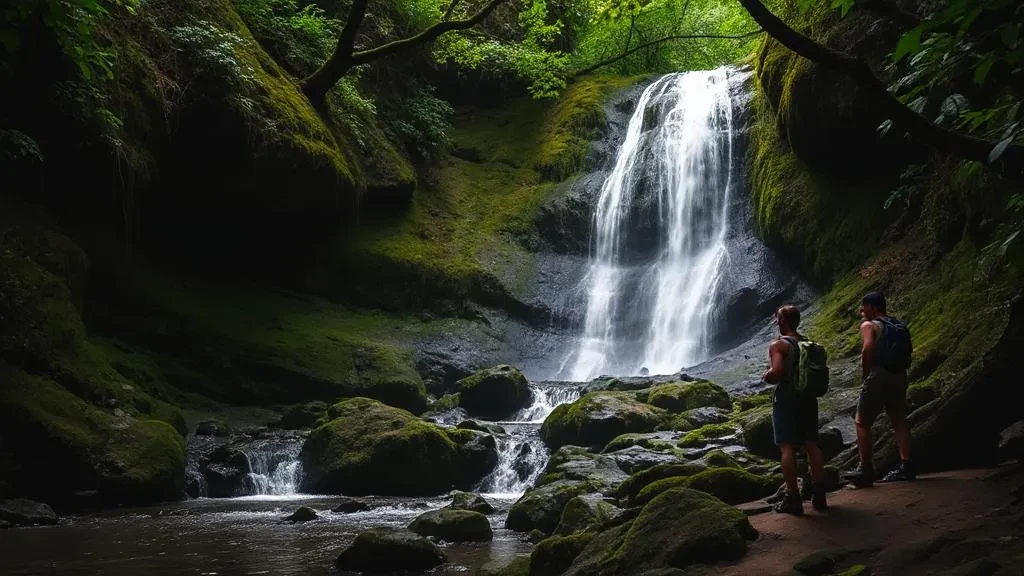
Located in the heart of Colorado Bend State Park, the Gorman Falls Trail is one of the most iconic waterfall hiking trails in Texas. This 3-mile round-trip hike leads to a stunning 70-foot spring-fed waterfall that cascades over mossy limestone cliffs into a lush, fern-covered grotto. The trail itself is moderately challenging, with some steep rocky sections that require careful footing—especially near the descent to the falls.
The trail is best hiked in the cooler months or early mornings due to minimal shade, but the reward is absolutely worth it. Gorman Falls is a prime example of how Texas’ geological diversity creates unique ecological pockets even in drier regions.
Expert Tip: Wear grippy hiking shoes, especially after rain, as the rocks near the waterfall can become slippery. Bring a reusable water bottle—hydration is crucial due to the rocky, sun-exposed path.
2. Pedernales Falls – Pedernales Falls State Park

Nestled in Texas Hill Country, Pedernales Falls State Park offers scenic hikes along cascading limestone ledges formed by the Pedernales River. While the park’s namesake falls are not towering, they are wide, dynamic, and uniquely beautiful—especially after rainfall. The Twin Falls Nature Trail is a short, shaded route that leads to a serene overlook of a hidden waterfall that many visitors miss.
The larger trail network in the park, including the Wolf Mountain Trail, provides excellent backcountry hiking for those wanting to explore further. These trails often follow ridge lines and valleys that give sweeping views of the Pedernales watershed.
Personal Insight: If you’re a photographer, visit during golden hour—either sunrise or sunset—to capture the light reflecting off the water-carved limestone.
3. Westcave Waterfall – Westcave Outdoor Discovery Center

One of the most enchanting waterfall hikes in Central Texas, the Westcave Waterfall Trail is located on private conservation land near Hamilton Pool. This guided hike takes you into a protected limestone grotto fed by a clear, cascading waterfall that flows into a jade-green pool below. The route winds through lush vegetation, caves, and dripping springs, offering a tropical-like contrast to typical dry Texas terrain.
Because the area is highly sensitive, hikes are guided and require a reservation. However, this makes the experience even more curated and informative—ideal for hikers interested in geology, ecology, or family-friendly educational hikes.
According to environmental educators at Westcave, the combination of high humidity and dense flora creates a rare microhabitat supporting species not found elsewhere in the region.
Expert Advice: Book in advance—spots fill quickly, especially in spring and early summer. Wear moisture-wicking clothes as the grotto area tends to be more humid than surrounding trails.
4. Hamilton Pool Preserve
While swimming access has varied in recent years due to falling rocks and water quality issues, the hike to Hamilton Pool remains one of the most breathtaking in Texas. The short trail leads to a collapsed grotto with a 50-foot waterfall pouring into an emerald pool beneath a natural rock amphitheater. It’s a must-see for anyone seeking dramatic waterfall scenery.
Though the hike is relatively short, the terrain can be uneven, and the path may be slippery during wet seasons. Reservations are mandatory for both hiking and potential swimming access.
LSI Keywords Applied: This is one of the most photographed hiking trails in Texas with waterfalls, often appearing in nature calendars and travel blogs due to its dramatic, oasis-like landscape.
5. Cattail Falls – Big Bend National Park
Big Bend is best known for its vast desert vistas and mountainous terrain, but it also hides one of Texas’ best-kept secrets: Cattail Falls. This moderate 5.5-mile trail leads into a quiet canyon where seasonal rainfall creates a tall, elegant waterfall pouring over volcanic rock formations. Because it’s relatively unknown and tucked away in the Chisos Mountains, you’ll often have the trail to yourself.
The falls flow only during wetter months, so plan your visit accordingly. The trail is shaded in places and features rich birdlife and desert flora unique to West Texas ecosystems.
Hiking Tip: Always carry at least 3 liters of water per person. Conditions can shift rapidly, and there’s no water source along the trail. Avoid hiking in extreme midday heat.
6. Wichita Falls Trail – Lucy Park
Located within Lucy Park in North Texas, this easy, family-friendly trail leads to a beautifully landscaped man-made waterfall. While not a natural fall, Wichita Falls is scenic and surrounded by wide, paved paths, making it accessible for all fitness levels and a good option for stroller walks or picnics.
The area is also known for its riverwalk, playgrounds, and wildlife sightings like herons and turtles. It’s a great urban hiking option if you’re in the Wichita Falls area and want a peaceful escape without a long drive.
Local Tip: Combine your visit with a walk along the Circle Trail, a 10-mile loop through parks and nature areas that surrounds the city.
Seasonal Hiking Guide: When & Where to Go
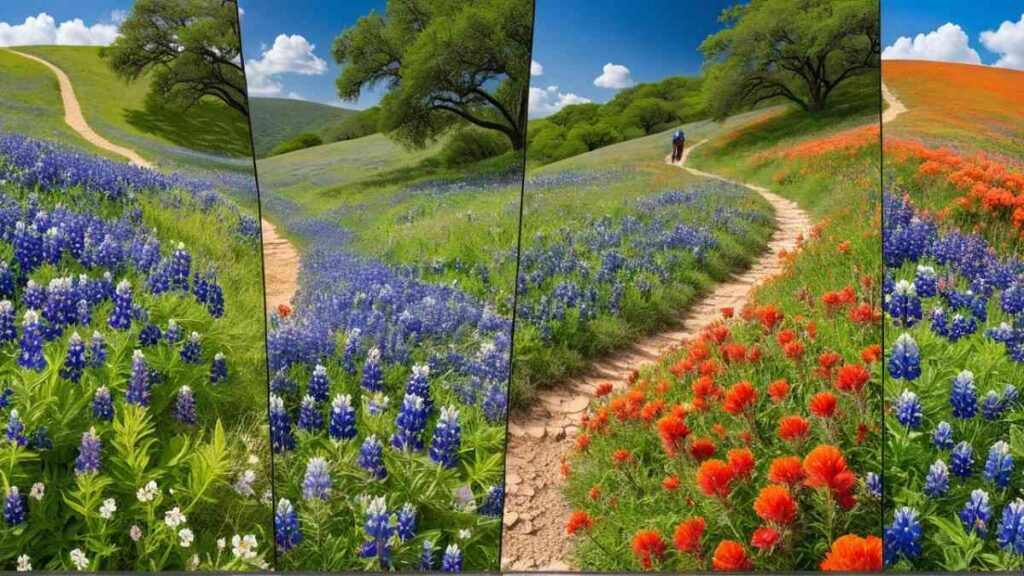
Hiking in Texas offers an evolving experience throughout the year, shaped by the state’s vast geography and changing climate. From wildflower-covered meadows in spring to crisp air and colorful foliage in fall, each season reveals a new side of Texas trails. To help you plan the perfect outdoor adventure, this seasonal hiking guide breaks down the best time to hike in Texas and pinpoints ideal trails for every time of year.
Spring Hikes in Texas
Spring is widely considered the best season for hiking in Texas. With temperatures ranging from the mid-60s to 80s and nature in full bloom, it’s a prime time to explore wildflower-rich trails and scenic overlooks. Many of Texas’ ecosystems—from Hill Country to Piney Woods—transform into vibrant, colorful landscapes.
1. Wild Basin Wilderness Preserve – Austin
This serene nature preserve offers a short network of trails bursting with wildflowers during March and April. Bluebonnets, Indian paintbrushes, and firewheels line the paths, making it a hotspot for nature photographers and families seeking accessible spring hikes. The shaded paths and well-maintained boardwalks cater to both beginner and intermediate hikers. Birds, butterflies, and small mammals are often spotted here, adding to the spring charm.
Experts from the Lady Bird Johnson Wildflower Center often recommend this trail as a low-impact introduction to spring botany in Texas.
2. Lost Maples State Natural Area – Vanderpool
Best known for its fall colors, Lost Maples also shines in the spring thanks to its dramatic limestone canyons, creeks, and diverse flora. The East Trail, in particular, showcases early blooms of Texas redbuds and mountain laurels.
Thanks to its higher elevation and canyon breeze, the park maintains cooler temperatures than surrounding regions—perfect for daytime hikes in late spring.
3. Enchanted Rock State Natural Area – Fredericksburg
Spring is the most comfortable season to hike Enchanted Rock, as the granite dome absorbs less heat and wildflowers bloom along the Summit Trail. The panoramic views are unmatched, and the cool spring air reduces the physical strain of the ascent.
Avoid weekends if possible, as the park gets very crowded during the peak bloom season.
Summer Hikes in Texas
Texas summers can be brutally hot, with many regions experiencing 95°F+ temperatures. However, that doesn’t mean you have to pause your hiking goals. The key is choosing early-morning hikes, elevated trails, or shade-rich forest routes to stay safe and cool.
1. Davis Mountains State Park – Fort Davis
The high elevation of this West Texas park—sitting at nearly 5,000 feet above sea level—makes it one of the coolest summer hiking destinations in the state. Trails like the Skyline Drive Trail offer scenic views of mountain ridges, desert plants, and cooler breezes. Thanks to its remoteness, this park is also a stargazing haven, perfect for early-morning hikes followed by overnight camping.
Start your hike by 6:30 AM and wrap up before 10:00 AM. Wear light-colored, moisture-wicking clothes and bring at least 3 liters of water.
2. Barton Creek Greenbelt – Austin
Running through the heart of Austin, this shaded creek-side trail is ideal for early-morning summer hikes. Multiple access points make it easy to plan short or long routes, and natural swimming holes like Twin Falls and Sculpture Falls offer a post-hike cooldown.
Safety Note: Avoid hiking here after heavy rain due to flash flooding risk in narrow sections of the creek.
3. Guadalupe Mountains National Park – Pine Springs
One of Texas’ few alpine-like environments, Guadalupe Mountains offers high-altitude trails with stunning views and slightly cooler temperatures. The Devil’s Hall Trail is a moderately challenging summer option with shaded canyons and narrow rock formations that provide occasional relief from the sun.
If you’re planning a high-altitude adventure, read our article on training for hiking to build the necessary endurance.
Fall Hikes in Texas
Autumn is a hiker’s dream in Texas. The summer heat begins to wane, and late October through November delivers vibrant foliage in select regions. These months also bring crisp air, golden light, and fewer bugs—ideal for longer hikes and weekend getaways.
1. Garner State Park – Concan
Located in the Hill Country, Garner State Park is a fall favorite due to its stunning foliage along the Frio River. Cypress, oak, and maple trees turn rich shades of orange, red, and yellow, especially on the Old Baldy Trail, which offers panoramic views of the autumn display. This trail is steep and rocky, but manageable for most hikers with moderate fitness levels. It’s one of the best fall hikes in Texas, especially for families seeking a classic seasonal experience.
2. Daingerfield State Park – East Texas
East Texas shines in the fall thanks to its denser, deciduous forests. Daingerfield State Park offers a tranquil 2.4-mile Rustling Leaves Trail that loops around a scenic lake, reflecting fall foliage in its still waters.
The trail is flat and shaded, making it ideal for a peaceful afternoon hike or a romantic fall walk.
3. Colorado Bend State Park – Bend
While famous for Gorman Falls (covered in waterfall hiking trails), Colorado Bend also offers rich fall hiking experiences. Trails like Spicewood Springs wind through forests that light up in late fall and include creek crossings and shaded paths perfect for photography.
Fall is a peak camping season in this park—book early for weekends and holidays.
Winter Hikes in Texas
While much of the country is blanketed in snow, Texas winter hiking is generally mild and accessible, especially in the southern and central parts of the state. Temperatures usually range between 40°F–65°F, allowing for longer hikes with fewer crowds and stunning low-angle winter sunlight.
1. Government Canyon State Natural Area – San Antonio
This park stays open year-round and features miles of rugged trails with scenic overlooks, historic sites, and fossilized dinosaur tracks. In winter, the exposed limestone trails are cooler, and visibility improves due to sparser foliage.
The Joe Johnston Route is a solid winter option, offering both historical interest and natural views in one moderately difficult trail.
2. Palo Duro Canyon – Canyon
Nicknamed the “Grand Canyon of Texas,” Palo Duro Canyon State Park is a must-visit in winter when temperatures are more manageable. The Lighthouse Trail offers iconic views of red rock formations and avoids the summer heat that can make this trail dangerous.
Mornings are frosty but clear—dress in light, layerable clothes and always check wind chill before starting the hike.
Before heading into colder trails, review our guide on cold weather hiking guide.
3. Hill Country State Natural Area – Bandera
This less-visited park features remote backcountry trails perfect for winter solitude. Trails like West Peak Overlook offer incredible views of the rolling Hill Country, especially when the air is crisp and visibility is high.
Texas Hiking Safety & Essentials
Gear Checklist
Hiking in Texas requires proper gear to tackle its diverse climates—from the blazing sun in the Hill Country to the cooler, rugged paths of West Texas. For any hiking in Texas adventure, start with a sturdy pair of hiking boots that offer excellent grip on rocky and uneven terrain. Opt for moisture-wicking clothes and a breathable, sun-protective hat to safeguard against Texas’s intense sun. It is also wise to pack a lightweight backpack filled with water, high-energy snacks, and a basic first-aid kit to ensure you’re prepared for unexpected situations.
In addition to footwear and clothing, consider essential navigation tools such as a reliable GPS device and a detailed Texas trail guide. Many experienced hikers also carry trekking poles, especially on longer or steeper trails like those found in the Texas hill country. For colder or variable weather conditions, layer your clothing so you can adjust as you ascend or descend from warmer areas. This gear checklist forms the basis of a successful day hike or extended backpacking trip in Texas.
Weather and Wildlife Tips
Texas weather can vary dramatically depending on the region and season. In the Hill Country, temperatures might soar during summer, while early mornings in West Texas offer refreshing, cooler conditions. Always check the weather forecast before setting out on a hiking in Texas adventure to avoid unexpected storms or excessive heat. If hiking during the hotter months, plan your trek during early morning hours and avoid midday hikes to reduce the risk of heat exhaustion and dehydration.
Wildlife is abundant in Texas, from the small critters inhabiting state parks to larger animals in more remote areas. While encounters are generally safe, it is crucial to maintain a respectful distance and never feed wild animals. Use insect repellent to ward off mosquitoes and ticks—common nuisances during both warm and transitional seasons. Experts recommend keeping a lookout for signs of wildlife activity along the trail and being familiar with local safety guidelines provided by park authorities, such as those available on the Texas Parks and Wildlife Department.
In regions like Sam Houston National Forest and Big Bend National Park, conditions can be unpredictable, so it’s important to dress appropriately and have contingency plans for potential weather changes or wildlife encounters. Practicing caution and staying informed ensures a safe and enjoyable hiking experience throughout Texas.
Rules for Hiking in Texas State Parks and National Forests
When exploring the great outdoors, adhering to local rules is essential for preserving the natural beauty of Texas and ensuring everyone’s safety. Most Texas hiking trails in state parks and national forests require that hikers obtain a permit or pay an entry fee. Always check the latest regulations on park websites, such as those provided by Texas State Parks, before you visit.
Following Leave No Trace principles is also crucial; pack out everything you bring in, minimize your impact on the environment, and respect wildlife habitats. Many parks have designated trails and specific routes to protect fragile ecosystems, so stick to these paths to help preserve the natural landscape. Additionally, be aware of restricted areas within parks and follow all posted guidelines, which are designed to keep both you and the environment safe.
Finally, always carry a map or a digital navigation tool because some trails in Texas, especially in remote areas like Big Bend, may lack clear signage. This not only enhances your own safety but also contributes to maintaining public trust and respect for these cherished natural resources. Consistently following park guidelines and obtaining any required permits will help you enjoy Texas’s amazing hiking destinations responsibly and sustainably.
Final Thoughts: Why Texas Is a Hiker’s Paradise
In summary, Texas offers a truly unique hiking experience that blends diverse landscapes, year-round opportunities, and a vibrant outdoor culture. From the iconic best hikes in Texas like Enchanted Rock and Guadalupe Peak to the urban escapes found on trails in Austin and Dallas, every trail tells its own story. Texas delivers an unparalleled mix of rugged mountain vistas, serene state parks, and breathtaking waterfalls—all accessible with the right preparation and local insights. This comprehensive guide has explored the best Texas hiking trails, practical tips, and expert advice to ensure your adventure is both safe and memorable.
Now it’s your turn to hit the trails and discover your own piece of Texas hiking paradise. Share your favorite hiking experiences and tips in the comments below, and subscribe for more expert guides on hiking in Texas, camping essentials, and outdoor adventures. For further reading, check out our related guides on Hiking Trail Guide and Best States for Hiking in USA. Your feedback and shared experiences help build an even richer community of outdoor enthusiasts ready to explore the best that Texas has to offer.
Ethan Marlowe is an experienced hiker and outdoor gear specialist based in Colorado. With over 7 years of hands-on experience trekking through the Rockies, Pacific Northwest, and East Coast trails, he delivers practical advice, expert gear reviews, and survival insights. His goal is to help hikers of all levels make smarter decisions on and off the trail.

